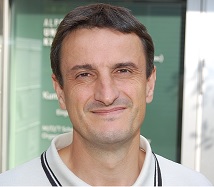 Vortragender:
Vortragender:
Assoc.-Prof. Dr.-Ing. György WERSÉNYI
Széchenyi István University, Györ, Hungary
Faculty of Engineering Sciences
Department of Telecommunications
Abstract:
Virtual Reality Simulators create a multisensory 3D space for subjects by using visual screens and auditory displays. In this multimedia presence, audio plays a significant role. Users often wear headphones and a virtual sound space is rendered with directional information.
In order to achieve this, psychoacoustic measurements, implementation of digital filters, subjective listening tests etc. are required. The whole process raises several problems, so information technology and engineering solutions may help reducing errors, inconvenience or even price.
Besides basic research questions about the human spatial hearing, measurement and playback systems support the development of assistive applications, devices mostly focused on people with disabilities, such as rehabilitation, sports or the community of the visually impaired.
Kurzbio:
György Wersényi was born in Györ, Hungary, in 1975. He received the M.Sc. degree in electrical engineering from the Technical University of Budapest, Hungary, in 1998 and the Ph.D. degree from the Brandenburgische Technische Universitat (BTU) Cottbus, Germany, in 2002. He has been a member of the Department of Telecommunications at the Szechenyi Istvan University, Hungary, since 2002.
He is an associate professor at the field of telecommunications, audio and video broadcast, and electroacoustics. His current research includes spatial hearing, listening tests, virtual audio displays, acoustic measurement, and dummy-head techniques.
Dr. Wersenyi is a member of the Audio Engineering Society, the Hungarian Telecommunication Society, and board member of the International Community for Auditory Display (ICAD).


 Abstract: Many daily activities we want to finish as fast and smoothly as possible. The same applies when we use our computing devices. Examples range from low-level actions, such as selecting the “Print” item from the “File” menu or clicking on desktop icons, to higher level activities and more complex tasks, such as finding the favorite holiday photo in the personal collection, or to use a smartphone to navigate a city map or to browse a long list of products before deciding on a purchase. Throughout the years, the desire for interaction efficiency has motivated the Human-Computer Interaction research community to seek and explore new interaction mechanisms and user interface techniques that improve on the state of the art. In this talk I will present a handful of past projects in which we have applied the experimental method to arrive at insights regarding novel user interface design solutions.
Abstract: Many daily activities we want to finish as fast and smoothly as possible. The same applies when we use our computing devices. Examples range from low-level actions, such as selecting the “Print” item from the “File” menu or clicking on desktop icons, to higher level activities and more complex tasks, such as finding the favorite holiday photo in the personal collection, or to use a smartphone to navigate a city map or to browse a long list of products before deciding on a purchase. Throughout the years, the desire for interaction efficiency has motivated the Human-Computer Interaction research community to seek and explore new interaction mechanisms and user interface techniques that improve on the state of the art. In this talk I will present a handful of past projects in which we have applied the experimental method to arrive at insights regarding novel user interface design solutions.
 Abstract: Software is omnipresent. It is key to successful businesses and has become key to our social activities. As many systems, also software systems need to change in order to stay successful on the market. However, these changes cause software systems to become larger in size and more complex as described by Lehman’s Laws of Software Evolution. As a consequence, more resources are needed to maintain, or in general, evolve a software system. Evolving software systems is therefore mastering change and system complexity. The goal of my research and teaching is to provide software engineers with means to master this challenge.
Abstract: Software is omnipresent. It is key to successful businesses and has become key to our social activities. As many systems, also software systems need to change in order to stay successful on the market. However, these changes cause software systems to become larger in size and more complex as described by Lehman’s Laws of Software Evolution. As a consequence, more resources are needed to maintain, or in general, evolve a software system. Evolving software systems is therefore mastering change and system complexity. The goal of my research and teaching is to provide software engineers with means to master this challenge.